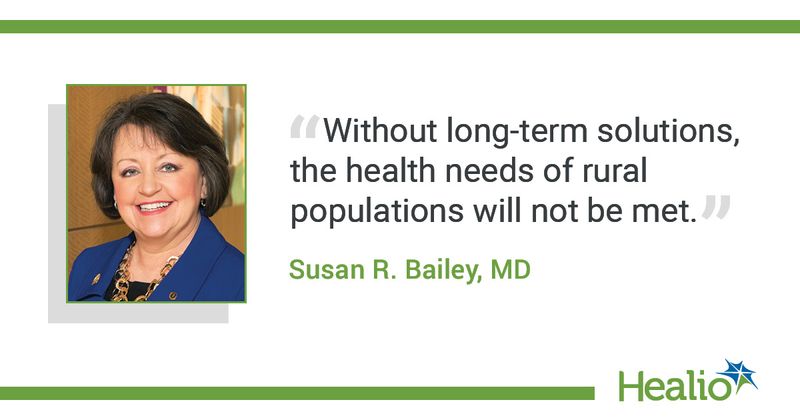AMA adopts new policies promoting equitable health care access
The AMA has approved new policies that aim to expand telehealth access, support struggling hospitals in rural areas and distribute COVID-19 resources to underserved communities.
The policies were adopted during the Special Meeting of the AMA House of Delegates.

Telehealth
In 2019, 25 million people in the United States did not have internet access, and 14 million did not own a smartphone or computer, according to the AMA. Internet access is particularly problematic in the Black and Latino communities, as well as for patients living in rural areas, the AMA said in a press release. Even those who have internet access often struggle with bandwidth issues.
To help “close the digital divide,” the AMA said its new policy calls on telehealth solution and service providers to consider accessibility, culture, language and digital literacy when designing functionality and content. The AMA also said it will support efforts to develop telehealth solutions for older adults, patients with vision impairment and those with disabilities.
In addition, the AMA policy supports the expansion of physician-practice eligibility for programs that facilitate the purchase of telehealth services and equipment. It calls on all health care stakeholders to be involved in efforts to expand telehealth access, including launch interventions and outreach programs.
“It is essential for physicians to serve as leading partners in efforts to improve access to telehealth services in historically marginalized and minoritized communities,” David H. Aizuss, MD, a member of the AMA Board of Trustees, said in a press release. “More of our patients used telehealth during the COVID-19 pandemic, and we should take advantage of this opportunity to ensure all our patients are able to benefit from being able to access and use telehealth services — regardless of their background or geographic location.”
Rural health
Another policy aims to improve health among Americans in rural areas, which “continues to lag behind those in suburban and urban areas,” the AMA said.
Specifically, the policy calls on public and private payers to support rural hospitals by:
- creating a capacity payment for essential services, such as surge capacity, regardless of volume;
- providing enough service-based payments to cover services in small communities;
- compensating physicians appropriately for being on-call so that small rural hospitals “can deliver quality services in a timely manner;”
- using only relevant quality measures and setting minimum volume thresholds;
- exempting rural hospitals from financial penalties for quality metrics that cannot be assessed; and
- creating voluntary monthly payments for primary care physicians so they have “the flexibility to deliver services in the most effective manner, with an expectation that some services will be provided via telehealth or telephone.”
The AMA said its policy also “encourages transparency among rural hospitals regarding their costs and quality outcomes,” and urges employers and rural residents to select health plans that “adequately and appropriately reimburse rural hospitals and physicians.”
“On average, rural residents are older, sicker and less likely to have health insurance — a particularly dangerous combination at a time when more than 40% of rural hospitals are at risk of closing,” AMA President Susan R. Bailey, MD, said in a press release. “Most of the hospitals at risk of closing are small rural hospitals, serving isolated communities. Without long-term solutions, the health needs of rural populations will not be met.”
COVID-19 resources
The AMA also adopted a policy that expands access to COVID-19 resources in low- and middle-income countries. The policy outlines ways to bolster the international production and distribution of COVID-19 treatments and vaccines, including efforts to temporarily waive intellectual properties.
In addition, the AMA said it will work with government and regulatory bodies to ensure equitable distribution of other COVID-19-related resources, including diagnostics and personal protective equipment.
“Even as we in the United States have easy access to vaccines, physicians and numerous organizations across the globe — particularly in low- and middle-income countries — are still risking their lives fighting COVID-19 in conditions where hospital capacity is strained, medical supplies are diminished and community spread is rampant,” AMA Board Chair-elect Bobby Mukkamala, MD, said in a press release. “The situation may seem to be getting better here, but in a global pandemic, threats abroad can quickly become threats in the United States and set us all back.”
References:
- AMA. AMA adopts new policies to bolster rural health care. Available at: https://www.ama-assn.org/press-center/press-releases/ama-adopts-new-policies-bolster-rural-health-care. Accessed June 15, 2021.
- AMA. AMA: Equity must be baked into expansion of telehealth. Available at: https://www.ama-assn.org/press-center/press-releases/ama-equity-must-be-baked-expansion-telehealth. Accessed June 15, 2021.
- AMA. AMA urges equitable resource distribution in fight against COVID-19. Available at: https://www.ama-assn.org/press-center/press-releases/ama-urges-equitable-resource-distribution-fight-against-covid-19. Accessed June 15, 2021.

